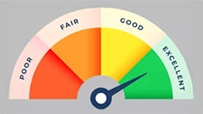Gold Loan Disbursement Process: What to Expect
Disclaimer: This blog is generic in nature. Please contact Ujjivan Small Finance Bank for details on Gold Loan disbursement process.
September 03, 2025

The Indian gold loan market has experienced significant growth, with its value reaching approximately ₹7.1 lakh crore in 2024. This expansion is largely attributed to the increasing demand for quick and accessible credit options, especially among individuals seeking to leverage their gold assets.
In the first half of FY25, banks reported a 43.4% rise in gold loan disbursements, underscoring the growing reliance on gold-backed financing. Despite this surge, the gold loan market's penetration remains at 5.6% of the total household gold, indicating substantial room for growth.
Understanding the gold loan disbursement process could be helpful for potential borrowers to navigate this financial avenue effectively. This blog provides a comprehensive, step-by-step guide to the gold loan disbursement process, empowering you to make informed decisions and efficiently access funds when needed.
Understanding Gold Loans
Before we delve into the disbursement process, let's take a moment to understand what a gold loan actually is. A gold loan is a secured loan where you pledge your gold jewellery or coins as collateral. The bank evaluates the value of the gold and disburses a loan amount based on that valuation. These loans typically have lower interest rates compared to other forms of loans, like personal loans, making them an attractive option for those in need of quick funds.
Gold Loan Disbursement Process
The process of obtaining a loan against gold jewellery is relatively simple compared to other forms of loans. Let's break it down step by step:
1. Application Process
To apply for a loan against gold, you need to specify the desired tenure and the amount required. The application can be done online; however, borrowers are required to visit the bank's facility to submit the physical gold. The processing fees for gold loans are minimal, starting from 0.1%, making it a cost-effective option compared to personal loans.
2. Verification by the Bank
Once you submit your application and documents, the bank will verify your identity and perform a purity check on your gold to ascertain its market value. This step ensures that both parties are aware of the value of the collateral.
3. Gold Valuation
The bank will evaluate the purity and weight of your gold ornaments or coins to determine its market value. The loan amount disbursed is typically up to 75% of the gold's value. For example, if your gold is valued at ₹10 lakh, you can expect a loan amount of up to ₹7.5 lakh.
4. Loan Approval and Disbursal
After verifying the documentation and gold valuation, the loan is processed and approved. The disbursal of loans against gold is incredibly fast, with eligible borrowers receiving instant approval and disbursement within minutes. The approval process for a gold loan does not heavily rely on factors like income or credit score, making it accessible to a wide range of individuals.
5. Storage and Insurance
Once the loan is approved, your gold is securely stored in a facility designated by the bank. The government mandates the secure storage of gold, and additional insurance cover is provided to protect against any unforeseen events such as theft. This insurance cover also ensures that your loan will be repaid in case of your unfortunate demise, relieving your family from any financial burden.
Final Thoughts
Gold loan disbursement process is generally efficient and straightforward, providing quick access to funds when you need them most. By understanding each step of the process, from application to fund disbursement, you can navigate it confidently.
Get Gold Loans up to ₹25 lakh at attractive interest rates with Ujjivan Small Finance Bank. Enjoy quick disbursal and a stress-free loan journey. Apply now!
Disclaimer:
The contents herein are only for informational purposes and generic in nature. The content does not amount to an offer, invitation or solicitation of any kind to buy or sell, and are not intended to create any legal rights or obligations. This information is subject to updation, completion, amendment and verification without notice. The contents herein are also subject to other product-specific terms and conditions, as well as any applicable third-party terms and conditions, for which Ujjivan Small Finance Bank assumes no responsibility or liability.
Nothing contained herein is intended to constitute financial, investment, legal, tax, or any other professional advice or opinion. Please obtain professional advice before making investment or any other decisions. Any investment decisions that may be made by the you shall be at your own sole discretion, independent analysis and evaluation of the risks involved. The use of any information set out in this document is entirely at the user’s own risk. Ujjivan Small Finance Bank Limited makes no representation or warranty, express or implied, as to the accuracy and completeness for any information herein. The Bank disclaims any and all liability for any loss or damage (direct, indirect, consequential, or otherwise) incurred by you due to use of or due to investment, product application decisions made by you on the basis of the contents herein. While the information is prepared in good faith from sources deemed reliable (including public sources), the Bank disclaims any liability with respect to accuracy of information or any error or omission or any loss or damage incurred by anyone in reliance on the contents herein, in any manner whatsoever.
To know more about Ujjivan Small Finance Bank Products Visit:"https://www.ujjivansfb.in"
All intellectual property rights, including copyrights, trademarks, and other proprietary rights, pertaining to the content and materials displayed herein, belong
to Ujjivan Small Finance Bank Limited or its licensors. Unauthorised use or misuse of any intellectual property, or other content displayed herein is strictly prohibited and the same is not intended for distribution to, or use by, any person in any jurisdiction where such distribution or use would (by reason of that person’s nationality, residence or otherwise) be contrary to law or registration or would subject Ujjivan Small Finance Bank Limited or its affiliates to any licensing or registration requirements.
FAQs
1. Can I get a gold loan without income proof?
Yes, you can obtain a gold loan without income proof. Unlike other loans, income proof is not required for a gold loan.
2. What is the maximum loan amount I can expect against my gold?
The maximum loan amount depends on the value of your gold. Banks typically provide loans up to 75% of the gold's market value.
3. Are there any tax benefits associated with a gold loan?
No, gold loans do not offer any tax benefits as they are secured loans backed by your gold assets.
4. Can I get multiple loans against different gold ornaments?
Yes, you can take multiple loans against different sets of gold ornaments as long as they meet the bank's requirements.
5. How long does it take for the gold valuation process?
The gold valuation process usually takes a few hours or less, depending on the bank's efficiency.
6. Is it necessary to have a bank account to get a gold loan?
Yes, most banks require you to have a bank account for loan disbursement and repayment purposes.
7. Can I extend the repayment tenure of my gold loan?
Some banks may offer options to extend the repayment tenure of your gold loan.
8. What happens if the gold valuation is lower than expected?
If the gold valuation is lower than expected, it may impact the loan amount offered by the bank.
9. What happens if I am unable to repay the loan?
If you are unable to repay the loan, the bank has the right to auction off the gold ornaments to recover their funds.
10. Can I get a higher loan amount if I pledge more gold?
Generally, the loan amount is directly proportional to the value of the gold pledged. Pledging more gold may result in a higher loan amount.
Latest Blogs

APK Fraud: How One Wrong Download Could Empty Your Bank Account
May 13, 2025
Picture this. You’re sipping your evening tea when your phone rings.

Gold Loan LTV Ratio Explained (75% to 85%): What It Means for Borrowers
March 20, 2025
In June 2025, the Reserve Bank of India (RBI) introduced a significant relaxation for gold loan borrowers: the maximum Loan-to-Value (LTV) ratio for loans below ₹2.5 lakh was raised to 85%, up from the long-standing cap of 75%. Loans between ₹2.5 lakh and ₹5 lakh can now go up to 80%, while loans above ₹5 lakh continue under the 75% ceiling.

Good Debt vs Bad Debt: Learn the Difference
August 13, 2025
Every month, millions of Indians wait for the familiar debit alert, an EMI deducted from their account.

Got a Tax Refund? 5 Smart Ways to Put Your 2025 Refund to Work
August 13, 2025
For many taxpayers, there’s a unique sense of relief when a tax refund arrives.

Credit Score Not Improving? 5 Mistakes You Might Be Making
August 13, 2025
For most of us, a credit score feels like a silent judge sitting in the background of our financial lives.




